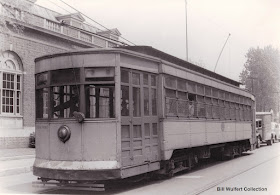This is what our CSL "Interstate," the 2846, looked like when it was new. South Chicago City Railway 338 later became CSL 2852; our car started out as SCCR 332. These cars were single-ended on SCCR, so this is the left or "blind" side of the car. Points of trivia: There's a drop platform at the rear, but not the front - the front had a steep step well of the same type as our older CA&E wood cars. Even though it was designed for single-end operation, there were poles and controllers at both ends. The car was heated by a coal-fired water heater at the front left corner, for which the stovepipe is obvious. It's not real obvious here but the front section of the car is convertible, and those are one-piece/two-light windows that would be removed (along with the section of car side underneath them) during the summer. The livery was vermilion with yellow along the windows, not too dissimilar from the later CSL colors.
Zoomed in, the herald on the side of the car says "Red Lines." The connecting Hammond Whiting & East Chicago, which ran joint through service with SCCR, was the "Green Lines."
Fast forward a few decades and this is Chicago & Calumet District Transit 74, formerly of the Hammond Whiting & East Chicago. It's pictured in front of the Whiting post office toward the end of its career. The HW&EC and then C&CDT had 16 cars of this design built between 1916 and 1919 (this car was from the final 1919 batch) by American Car Company. Though resembling CSL "Big Pullmans," they had steel bodies and Brill 77E trucks. The highest-numbered 11 cars of this type were rebuilt for one-man service in 1932 (note the lack of steps at this corner) and thereafter the rest of the company's fleet was effectively retired. The last C&CDT car ran in June 1940.
Here's a rare interior photo of C&CDT 74. My guess is that this was taken after it had been retired because the controller is missing! Some points of trivia: note space to mount two fare registers, one for each side of the state line (CSL 2846 at IRM has this same feature); over the motorman's head you can see a variety of switches as well as a mirror for keeping an eye on the passengers; despite being converted to one-man operation, the car retains the original twin doorways to the platform, similar to Chicago two-man cars; and by the motorman's right hand you can see what looks like two hand cranks to operate the doors, similar to how C&WT 141 is set up at IRM.
This CSL company photo of car 2853 is dated July 30, 1915. Car 2853 is just one number off of the car shown above, but this depicts it after the major rebuilding this entire series underwent in 1910. Other than keeping the railroad roof, most of the odd aspects of the car design were changed to "BOSE standard" including double-ended layout, longer platforms, no convertible section or mid-car bulkhead, and electric heat.
This terrific photo shows South Chicago City Railway 204, a big double-truck open car built in the company shops, crossing the B&O at Baltimore & 83rd Street. These 200-series open cars are described in Bion Arnold's 1908 valuation report of SCCR, but they're listed as unpowered trailers, probably pulled most commonly by "Interstates" like car 332 above. It also describes them as having been built in 1908, though that could be when they were rebuilt as trailers (or was 204 later rebuilt as a motor car?). Anyway, car 204 shows off some interesting traits including corner boarding with a center aisle; fixed back-to-back benches, which were quite common in Chicago in the late 19th century, rather than the flip-over reversible benches more commonly seen elsewhere; Peckham 18CX trucks; and what looks like a D1-EG air compressor, the same type as the two ex-SCCR cars in IRM's collection had when built.Fast forward a few decades and this is Chicago & Calumet District Transit 74, formerly of the Hammond Whiting & East Chicago. It's pictured in front of the Whiting post office toward the end of its career. The HW&EC and then C&CDT had 16 cars of this design built between 1916 and 1919 (this car was from the final 1919 batch) by American Car Company. Though resembling CSL "Big Pullmans," they had steel bodies and Brill 77E trucks. The highest-numbered 11 cars of this type were rebuilt for one-man service in 1932 (note the lack of steps at this corner) and thereafter the rest of the company's fleet was effectively retired. The last C&CDT car ran in June 1940.
Here's a rare interior photo of C&CDT 74. My guess is that this was taken after it had been retired because the controller is missing! Some points of trivia: note space to mount two fare registers, one for each side of the state line (CSL 2846 at IRM has this same feature); over the motorman's head you can see a variety of switches as well as a mirror for keeping an eye on the passengers; despite being converted to one-man operation, the car retains the original twin doorways to the platform, similar to Chicago two-man cars; and by the motorman's right hand you can see what looks like two hand cranks to operate the doors, similar to how C&WT 141 is set up at IRM.






No comments:
Post a Comment
Please identify yourself with a name of some sort in your comment. Completely anonymous comments will be deleted. Thanks!